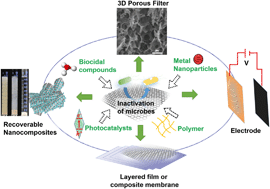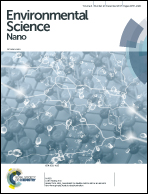Graphene-based antimicrobial nanomaterials: rational design and applications for water disinfection and microbial control
Abstract
Antimicrobial nanomaterials for water treatment have attracted ever-growing research attention as they provide alternative approaches for disinfection and microbial control. Among all the antimicrobial nanomaterials, graphene-based nanomaterials have emerged recently. This review article seeks to provide a whole view on graphene-based antimicrobial nanomaterials particularly applied for water disinfection and pathogenic microorganism control. Herein, we firstly give a brief introduction of the antimicrobial characteristics of single-component graphene materials. In the following section, the functionalization of graphene with metal nanoparticles, photocatalysts, polymers and biocidal compounds for tailorable antimicrobial activities and microbial inactivation is thoroughly reviewed. In addition, innovative devices (hydrogel, thin film, composite membrane, recoverable nanocomposite and electrode) assembled from graphene-based nanomaterials used for water disinfection and microbial control are discussed in detail. Finally, the future opportunities and challenges of designing graphene-based antimicrobial nanomaterials for water disinfection are addressed.



 Please wait while we load your content...
Please wait while we load your content...